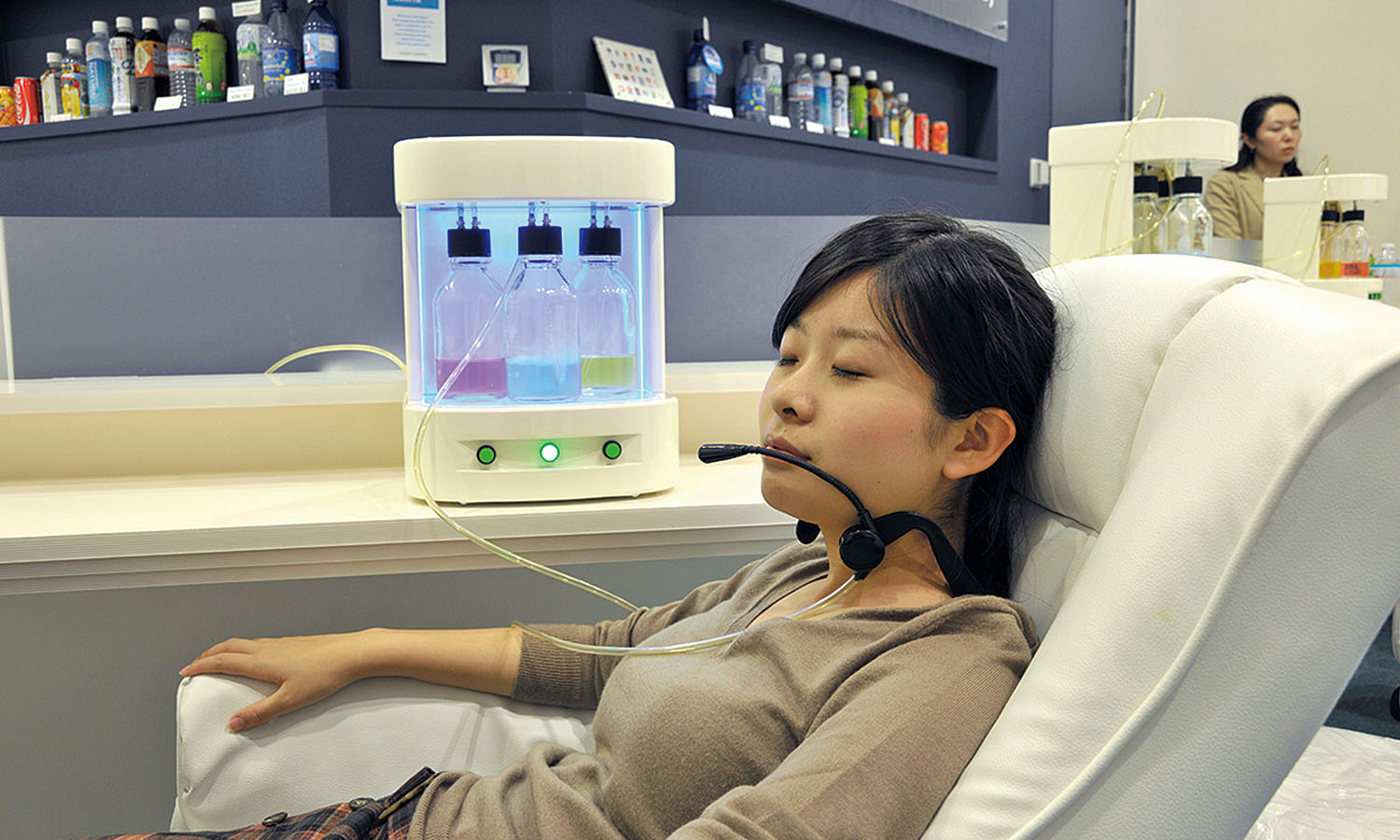Tokyo's Narita International Airport has an Oxygen Lounge in its arsenal. While the concept may not be new, it is interesting. For $6, a passenger can get 10 minutes of high-grade oxygen to help de-stress after a long flight. The airport even offers different flavors, should you want to avoid breathing bland air.

What are the Benefits?
Most claims about the benefits of oxygen bars have yet to be scientifically proven. Proponents of oxygen bars claim purified oxygen can help:
- Increase energy levels
- improve mood
- improve concentration
- improve sports performance
- reduce stress
- provide relief for headache and migraine
- promote better sleep
In an older study from 1990, researchers surveyed 30 participants with chronic pulmonary obstructive disorder (COPD) who used oxygen therapy over several months. The majority of participants reported an improvement in well-being, alertness, and sleep patterns.

However, the participants used oxygen therapy continuously for several hours a day over an extended period. And while the patients felt an improvement, the researchers needed to figure out how much of the perceived improvement resulted from a placebo effect.
Evidence shows that supplemental oxygen may improve sleep in people with sleep apnea. Sleep apnea is a condition that causes a person to stop breathing during sleep periodically. There doesn't appear to be any aid to sleep in people without this condition. There's limited evidence that oxygen therapy may help cluster headaches. No adverse effects were noted, though more research is needed.

If you don't have any medical conditions that can be worsened by extra oxygen, you may experience an improvement in the effects of stress. Tokyo's Oxygen Lounge may be the perfect rest after a long flight.
Even so, the positive effects reported by people who frequent oxygen bars may be psychological, or some benefits still need to be studied.

Are Oxygen Bars Really Safe?
The benefits of oxygen bars have yet to be studied, and neither have the risks. A healthy person's normal blood oxygen is between 96 and 99 percent saturated with oxygen when breathing normal air, which makes some experts question what value extra oxygen could have.
Some medical conditions benefit from supplemental oxygen, but even for these people, getting too much can be harmful and even deadly, according to research. Administering oxygen to people admitted to the hospital with acute illnesses is a long-held standard practice.

However, a study published in 2018 in The Lancet found evidence that oxygen therapy may increase the risk of death when given liberally to people with acute illness and trauma.
The scents are delivered by bubbling the oxygen through a liquid containing either an oil-free, food-grade additive or an aroma oil such as an essential oil. Inhaling oily substances can potentially lead to a serious inflammation of the lungs, known as lipoid pneumonia.

The scents used in scented oxygen can also harm some people, especially those with lung diseases. According to the Lung Association, the chemicals in scents and even those made from natural plant extracts can cause allergic reactions that can range from mild to severe. Reactions to scents can include symptoms such as:
- Headaches
- Dizziness
- Shortness of breath
- Nausea
- Worsening of asthma
Surprisingly, fire is also a concern whenever dealing with oxygen. Oxygen may be nonflammable, but it does support combustion.

Who should avoid oxygen bars?
Avoid oxygen bars if you have a respiratory condition, such as:
- COPD
- Cystic fibrosis
- Asthma
- Emphysema
It would be a good idea to ask your doctor before using an oxygen bar if you have a heart condition, vascular disorder, or other chronic medical condition.

If none of these apply to you, then the Narita International Airport Oxygen Lounge may be the perfect place to relieve your tension and relax a little more.
Southwest and Turkish Airlines Unveil 2026 Partnership » Memphis at Midnight: Inside FedEx's Global Superhub » Air France Suspends Paris-Manila Service for Summer 2026 »
Comments (0)
Add Your Comment
SHARE
TAGS
INFORMATIONAL Tokyo NRT Narita Airport Lounge Exclusive Amenities ANA Japan AirlinesRECENTLY PUBLISHED
 Mexican Medical Plane Crashes in Galveston Bay During Rescue Mission
Search and rescue operations are continuing into the evening in West Galveston Bay following the crash of a Mexican military medical flight. The Beech King Air 350, which was carrying eight people (two pilots and six passengers), went down around 3:15 p.m. on Monday as it approached Scholes International Airport.
NEWS
READ MORE »
Mexican Medical Plane Crashes in Galveston Bay During Rescue Mission
Search and rescue operations are continuing into the evening in West Galveston Bay following the crash of a Mexican military medical flight. The Beech King Air 350, which was carrying eight people (two pilots and six passengers), went down around 3:15 p.m. on Monday as it approached Scholes International Airport.
NEWS
READ MORE »
 Direct Minsk-New York Flights? Belavia Weighs Transatlantic Return for 2026
Following a series of diplomatic breakthroughs in late 2025, Belavia, Belarusian Airlines, is officially exploring the feasibility of a direct link between Minsk National Airport (MSQ) and New York's John F. Kennedy International Airport (JFK).
ROUTES
READ MORE »
Direct Minsk-New York Flights? Belavia Weighs Transatlantic Return for 2026
Following a series of diplomatic breakthroughs in late 2025, Belavia, Belarusian Airlines, is officially exploring the feasibility of a direct link between Minsk National Airport (MSQ) and New York's John F. Kennedy International Airport (JFK).
ROUTES
READ MORE »
 Air France Suspends Paris-Manila Service for Summer 2026
Air France has announced a significant adjustment to its Southeast Asian network, confirming that its direct service between Paris Charles de Gaulle (CDG) and Manila (MNL) will transition from year-round to seasonal operation starting in 2026.
ROUTES
READ MORE »
Air France Suspends Paris-Manila Service for Summer 2026
Air France has announced a significant adjustment to its Southeast Asian network, confirming that its direct service between Paris Charles de Gaulle (CDG) and Manila (MNL) will transition from year-round to seasonal operation starting in 2026.
ROUTES
READ MORE »



